Lighting was key to making the Capitol Theatre unique when it opened in 1924 so it’s fitting that The Capitol still has fantastic lighting after its recent refurb. Great venue for MIFF.
My experience at the cinema
We were excited to get to the newly-refurbished Capitol Theatre in Melbourne just a few weeks after it re-opened in June 2019. It is now a multi-purpose cultural venue re-branded as The Capitol, but it still shows films when events like the Melbourne International Film Festival are on.
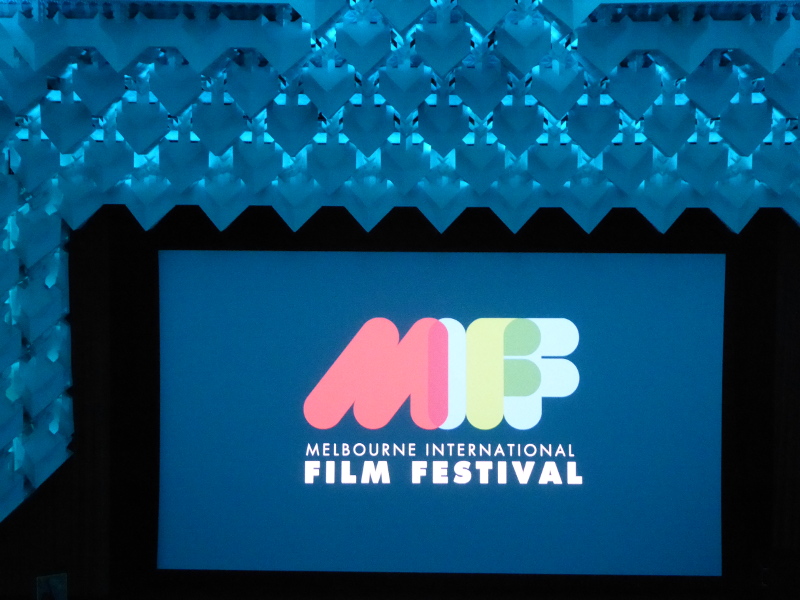
So we came to see a very intense Hungarian drama set just before the First World War. I wouldn’t usually go into the content of the film we see for this blog, but in this case it is kind of relevant, since sound and light are key parts of both the film itself and the superbly-modern Capitol in the 21st century.

We could tell the acoustics would be good as soon as we took our seats high up towards the back of the auditorium. The design of the walls and ceilings muffled the sound of the 600 or so people excitedly picking their spots and getting ready for the film.
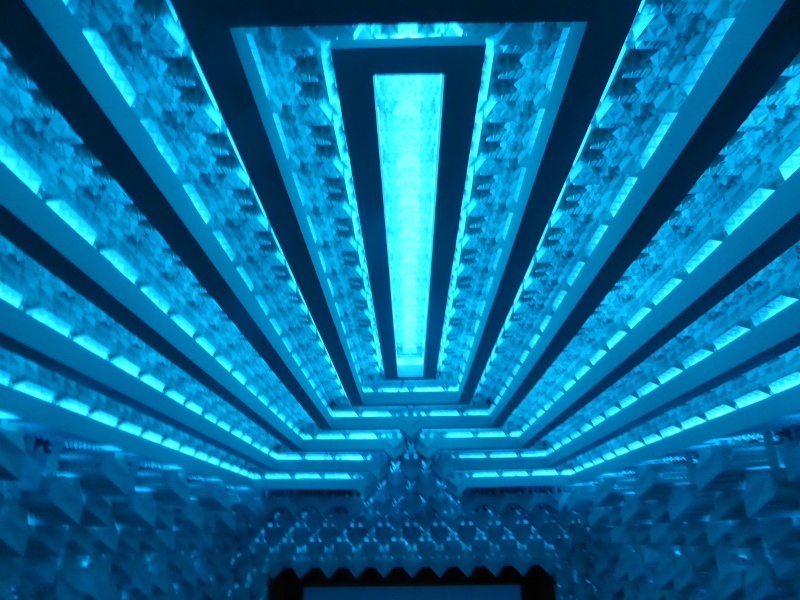
And when the film began, there wasn’t that echoing blast of volume you get in some cinemas today. But then muffled whispering was the general tone of the film we saw, so that may have been a factor in the effect on us as viewers (and listeners).
Mind you, my only gripe about the sound in The Capitol today is a personal one. I can’t stand Surround Sound; my brain can’t cope with sounds from speakers behind me or worse still, beside me when I’m watching a film down below me on the screen.
I know the idea of Dolby Surround Sound was to make you feel part of the action, to get inside the head of the person on the screen, but it actually has a more Brechtian, alienating effect on me as a cinema-goer, so that’s a thumbs down from me on that aspect of the new theatre.
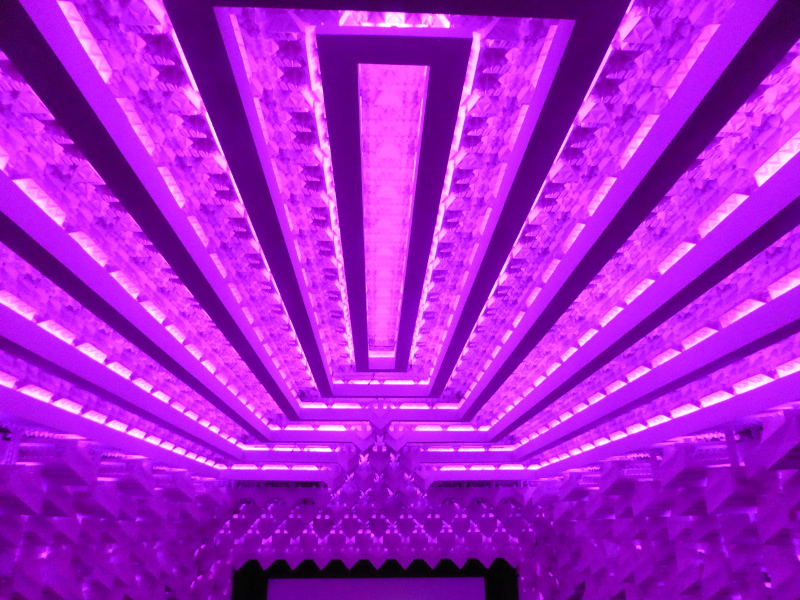
Overall, the refurb is astonishingly beautiful. The coloured LED lights that change the look of the auditorium every few seconds as you wait for the film to start are just extraordinary, and a really nice link back to the original 1920s Capitol, which prided itself on its illumination – as well as the music – to make that silent movie experience all the more magical.
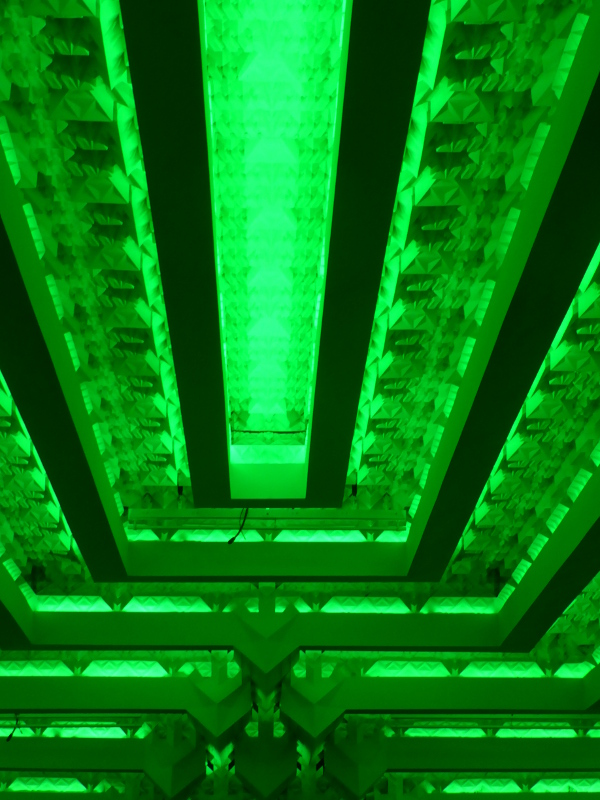
When we first arrived for the film – about half an hour ahead of start-time – we were disappointed to be told to join a long queue lining its way down Swanston Street and curling round towards Collins Street. I mean it’s great that an obscure film like this was so popular, and that says a lot for the cultured folk of Melbourne, but we had got there early precisely to have a good look around at the refurbishment before we sat down.
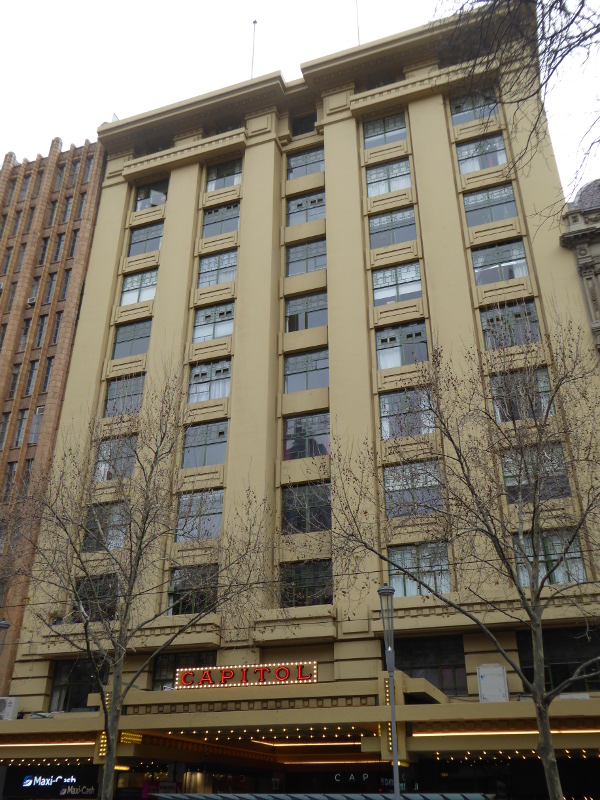
In the end, that wait was made quite a bit better by getting into a lovely conversation with the couple in front of us, both of whom had also come I think mainly for a sticky beak at the architecture, and like us are big fans of the Regent Theatre in Ballarat, having once lived there themselves. So, thanks Joan and Gerard for the entertaining exchange and we hope you enjoyed The Capitol as much as we did.
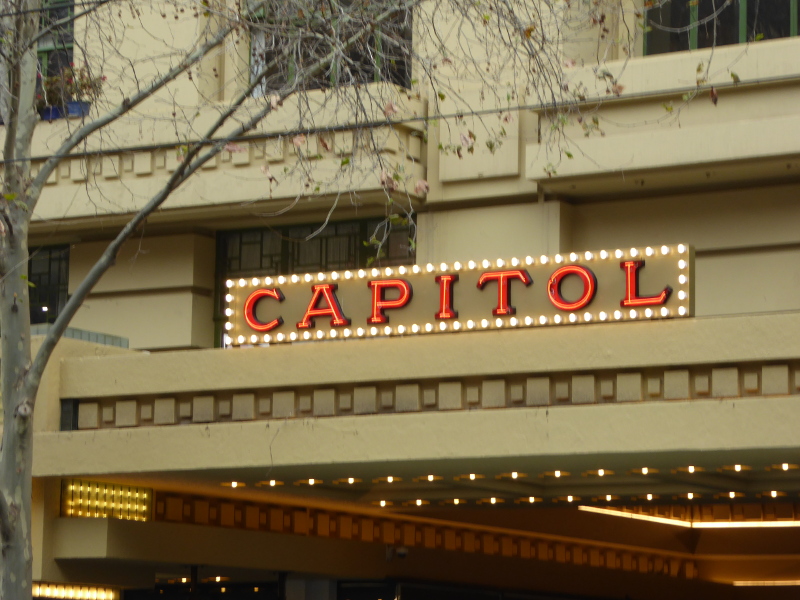
Some people might say Vintage Victoria is all about nostalgia, and it’s true I do love old buildings that preserve lots of original features, but if you’re going to bring a building into the 21st century, the way The Capitol’s refurb has been done is the way to go, surely.
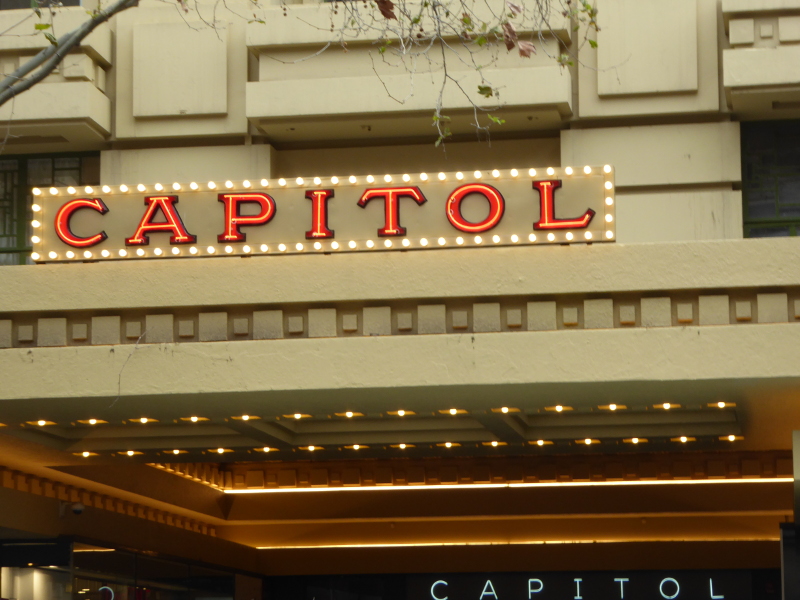
They’ve kept the old art deco frontage, with its lovely lettering and old-fashioned light bulbs, but have made the interior into this extraordinary work of art, in which that lighting is probably the masterpiece, but only in conjunction with the amazing lining of the walls.

There are other nods to the original Capitol Theatre in the design of the carpets in the foyer.
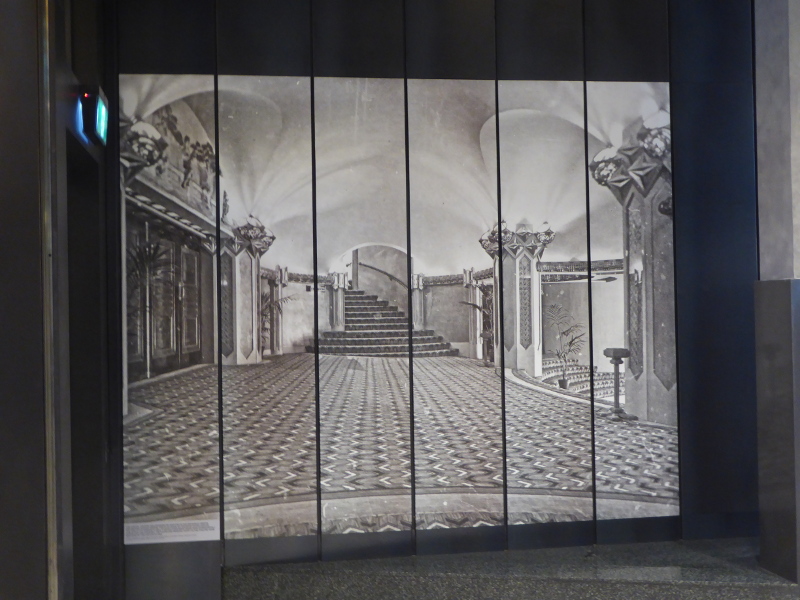
That closely resembles the pattern on the floor of the old theatre from the 1920s, which you can see outside on the wall of the arcade downstairs.

And I rather liked the box seats round the sides, though they probably wouldn’t be filled for a film. Did anybody ever sit in box seats for a movie in the old days?
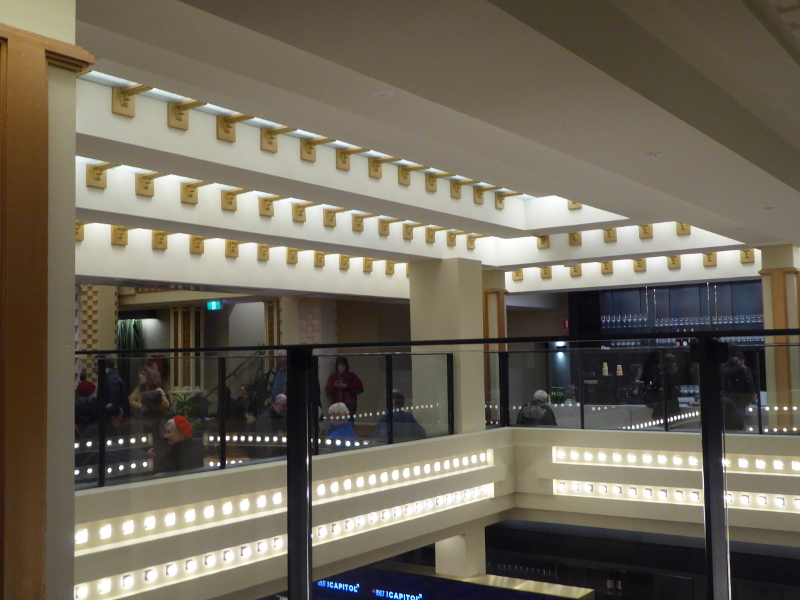
Then after the film, we waited a while in The Salon, which is basically a modern bar for after-film drinks. It’s all bit contemporary for my liking, but again even here they have referenced back to the old Capitol Theatre with the tiling on the columns.
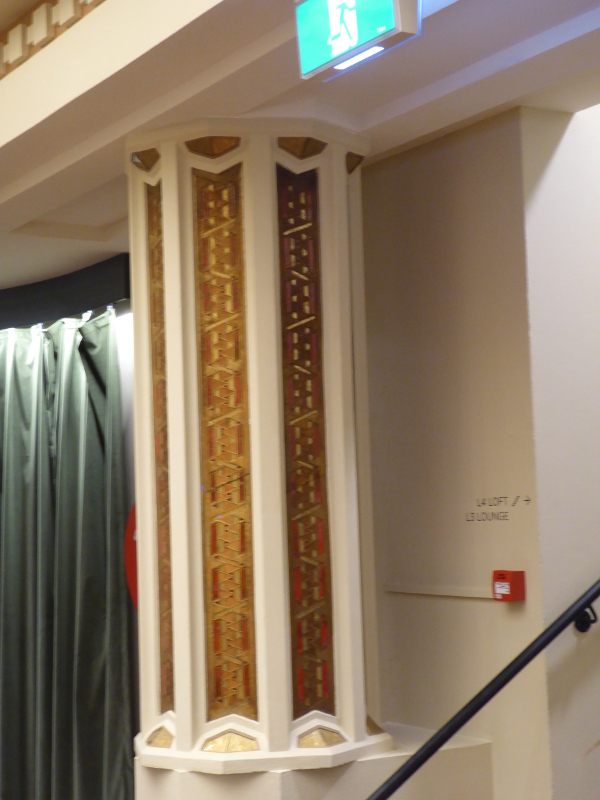
By then, the snaking line for the next film was being allowed to move forward into the cinema, and another episode of the Capitol’s story was about to commence. I love this place, and hope to come back for more at next year’s MIFF…
Practicalities
They don’t often show films at The Capitol these days, but it seems to be a regular venue for the Melbourne International Film Festival so you can certainly watch a movie in August there.
There are other cultural events at other times of the year, but there seems to be no access to the foyer upstairs except when an event is on.
History and stories about the The Capitol Theatre
The Capitol Theatre first opened in November 1924, with a screening of Cecil B. De Mille’s ‘The Ten Commandments”, though this was not the Yul Brynner version, which was De Mille’s remake 30 years later!
Still it was a sell-out and ran to packed houses at the Capitol for 19 weeks, press reports reckoning 700,000 people saw the film at the Capitol in the 2137 seats capacity the cinema held in those days.
Paramount even had a chariot that had been used in the filming shipped over to Melbourne for display in the Capitol foyer, so a lot of people will have come for that, as well as a first sight of this palatial theatre.
This was of course the era of the silent movies, so the Capitol pulled out all the stops with a beautiful Wurlitzer organ (the first in Australia), full orchestra, and a system of lighting which was supposed to enhance the atmosphere for movie-goers. No wonder people flocked to the place, and I can imagine many of the 700,000 were repeat visitors!
Most of the Trove press clippings on the Capitol have Hollywood gossip or simply review the films on show each week.
But there were also celebrity competitions like the ‘Margie Quest’ in January 1948. The cinema was screening a film called ‘Margie’, starring Jeanne Crain, and women were encouraged to send in a photo of themselves with their name and address on the back if they thought they looked like Crain, or embodied the ‘spirit and ingenuous appeal of Margie’. No worries about data protection in those days, and the entries had to be sent simply to: ‘Capitol Theatre, Melbourne”. I wonder who won?
In 1932, the hide of champion race horse Phar Lap, was stuffed by a taxidermist and displayed as a real life-size model in the foyer of the Capitol.
But occasionally, other more political incidents cropped up.
In 1938, when the Japanese bombed and invaded China, a massive fund-raiser was organised at the Capitol for ‘civilian relief’.
In 1948, the Cold War was just heating up, so to speak. And when the Capitol showed a Canadian spy film called ‘The Iron Curtain’, there were demonstrations and scuffles between two sets of supporters of different sides of the argument, with a police car driven along the footpath to break up a Communist demonstration.
And just occasionally a member of the Capitol staff would make the news for more personal reasons. So it was with violinist Otto Agne, who was assaulted and insulted in 1927, bringing a case to court against his attacker. It looks as though the assailant had started an affair with Mr Agne’s wife, which led to a confrontation on Hawthorn station platform one evening. Agne accused his attacker of saying: “take that, you dirty German,” as he was struck on the jaw (of course we were just 9 years since hostilities had ended in WW1 so anti-German feelings would still run high in many quarters…), though the court dismissed the ‘insulting words’ charge.
The Capitol seemed to avoid the terrible fires that hit many cinemas at some point in their lives. There was a brief report in a regional newspaper about a small fire in 1925, which injured two members of Capitol staff (called ‘employes’ in those days), but the audience left the theatre calmly and there was little damage to the building.
The Capitol Theatre did not however survive the ravages of television and it closed in 1964 for a complete refurb, with the famous old wurlitzer removed to the Dendy in Brighton apparently, though I haven’t seen that confirmed anywhere. The cinema re-opened in December 1965 with only 600 seats, and the ground floor now taken up by an arcade (so I might one day review the arcade that still exists – although rather modern now) underneath the current Capitol Theatre.
By the 1990s it was only being used for film festivals or for screening Chinese and Indian films on the whole.
But then in 1999 the current owners, the RMIT, bought the theatre, and used it for lectures. Who were the lucky students who had their lectures in the Capitol auditorium, and how inspiring was that as a place to learn?
The RMIT organised free public tours of the building from 2000-10 but then when interest declined, they decided to stop, until someone came up with the brainwave to seek funding for the magnificent overhaul of the building we see today. Well done, RMIT, is all I can say.
Other links and writings on the The Capitol
The Guardian published a nice piece on the history of the Capitol Theatre and the refurb – it notes that it was a woman architect with her partner who was involved in the original 1920s design.
This is Hidden Melbourne’s take on the Capitol – with some lovely photos.
The Cinema Treasures website has an entry on The Capitol Theatre.
This amazing Wolfgang Sievers photo on the National Gallery of Australia website from the 1980s hows how closely the new refurb of the Capitol kept to the old design.
This Youtube video has lots of still shots from the original Capitol and the new refurb.
This fascinating article from 2011 covers the work of architect Marion Mahoney and includes the Capitol though it pre-dates the recent work carried out.
People connected to the The Capitol
The character who drew my attention in connection with the Capitol Theatre when it first opened was a Mr James Thornley. Thornley was an enterprising chap who was general manager of the theatre when it opened, and was profiled by The Herald newspaper when he set off on a world tour in 1926 to study how other countries built and used movie theatres, and to pick up ideas of screening films.
A man of great vision – bringing over the chariots from the set of the Ten Commandments – and an eye for practical improvements – he patented a device by which a ‘monitor’ in the cinema audience could adjust the volume as each reel was shown as sound varied quite erratically in the early ‘talkie’ years.
He wasn’t always open to changes, though. When the Tivoli Theatre decided (temporarily, due to the outrage that followed) to stop playing the National Anthem after each evening screening because it was usually a signal for the audience to rush to the doors, Mr Thornley refused to end the custom and said: “We don’t find much diving for the aisles…”
In 1936 Thornley went to Hollywood, where he met Bing Crosby, revealing to a magazine after his visit that Mr Crosby had a ‘remarkable knowledge’ of Australian horse-racing. On that same trip he met Cecil B De Mille, who was still making movies in the 1930s.
He retired from his role as manager of the Capitol in 1938.
What are your memories of the The Capitol Theatre?
Is there anybody still around today who can remember going to the Capitol Theatre when the old wurlitzer was still here before the 1960s redesign?
What’s the best film you’ve seen there or was it a musical or cultural event you attended that sticks with you as a great memory?
Did anybody reading this attend RMIT lectures at the Capitol Theatre? How good was that? Tell us about it.
Has anybody else been to the new Capitol and what are your thoughts on the place now?
Coffee or tea before the pic or after?
We’re really close to the Manchester Unity Arcade here so unless it’s a Sunday, head round to the Switchboard Cafe in the MU building. Sundays are trickier in this part of Melbourne. Anybody got a good tip for coffee then?


“Hidden from public gaze for five years, one of the jewels in Melbourne’s architectural crown, The Capitol – a 1920s design triumph of Walter Burley Griffin and Marion Mahony Griffin – has reopened its doors.”
Of course Walter Burley Griffin and Marion Mahony Griffin are famous for desiging Canberra
It was so sad to see this magnificent large theatre have the Stalls section gutted in the 1960s and turned into a very ordinary scruffy and for a long time unsuccessful arcade
The Capitol was always the ugly duckling of the Hoyts group as they didnt own the building only leased it.
Quite often Hoyts would put on their second best films on at the capitol the best being kept for the Regent,Plaza and Esquire cinemas in the CBD
May I confirm for you that the 3/15 Wurlitzer Theatre Pipe Organ was purchased by the newly formed Theatre Organ Society of Australia (Victorian Division) in 1963. This Society removed the organ from the Capitol Theatre and with the agreement of the Ward Family, (owners of the Dendy Theatre, Brighton), reinstalled the organ in the Dendy Theatre. The organ remained in what became Cinema 4 of Palace Dendy Theatre Cinemas, Brighton until this year. It is currently being removed from the Dendy to go into storage at R.M.I.T. to be reinstalled back in the Capitol Theatre. The organ chambers remain in the Capitol, but need to be brought up to today’s engineering standards. Funds are being raised to achieve this – then the organ can return from where it came.
I am a member of the Theatre Organ Society of Aust. (Victorian Division)Inc serving on its Committee of Management having preciously served as President for 20 years.
That’s great news, John. Thanks for the update. Love to hear when the organ returns!
Was there a nightclub downstairs at the Capitol building in Swanston Street in 1989? If so what was it’s name?
Thanks Mark
Hi. Thanks for the article. James Thornley (Manager of the Capitol 1930s) is my grandfather. Can you let me know what your source is for that paragraph on his work at the Capitol?
Thanks for this Jeni – great to see you found my entry; I will look back on the Trove press cuttings database and get you an exact reference. I enjoyed reading about his extraordinary career.
Thanks 🙏 Simon! I really appreciate that. I’m a documentary filmmaker – and the Thornley’s picture business has had a huge impact on my life! JL (James) died in Melbourne c1956 and that coincided with the arrival of television. We were in Tasmania and dad (Brian Thornley) ran the Launceston Plaza and cinemas in Hobart. We moved to Melbourne in 56 for Dad to take over the family cinema business with his brother. It was a traumatic time!